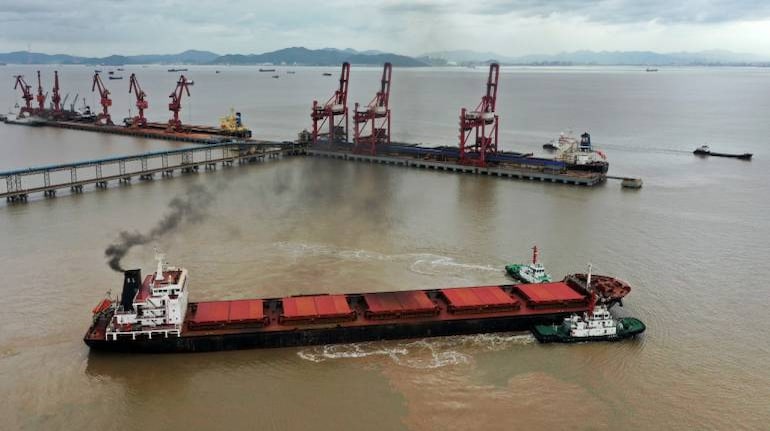



Indian rice exports have got a shot in the arm with the Andhra Pradesh government allowing shippers to make use of the Kakinada deep-water port that will help double shipments and cut the waiting time for ships.
In an order issued on February 3, the Andhra government allowed the Kakinada deep port to be used for rice export by the Agricultural and Processed Food Products Export Development Authority (APEDA) to help clear congestion at the Kakinada anchorage port.
APEDA supervises and registers Indian rice exports.
The deep-water port will be used temporarily to clear rice shipments until the anchorage port is developed to handle the huge traffic.
It takes 30 days for loading rice. With the deep water port coming into use, the time will be cut to 20 days, according to BV Krishna Rao, The Rice Exporters Association President.
Faster shipmentPawan Agarwal, Special Secretary, Logistics, Ministry of Commerce and Industry, said the move followed his visit to the Kakinada port in January where he found a large number of ships berthed in deep sea water waiting for the consignment to be loaded at the anchorage port.
“We are extremely grateful to the Andhra Pradesh Government for allowing us to use the deep sea water port,” he said.
“The problem at the Kakinada anchorage port was that we load three lakh tonnes of rice every month. Though 20 vessels come for loading, rice consignments are loaded in only seven vessels,” Rao said.
The Kakinada deep port is alongside the anchorage port under the control of the Andhra Pradesh Maritime Board. It was idle most of the time but the port workers did not allow its use.
“Just because a few people did not want the deep-water port to be used, it could not be a reason to deny export. The logistics secretary impressed upon the state government to open it up and thus help in doubling the handling capacity to over six lakh tonnes,” Rao said.
Rise in rice demandCongestion had built up as rice from India, which has been holding huge stocks thanks to record harvest last season and a good kharif crop this year, has been in demand in the global market.
India had 18.66 million tonnes of rice as stocks besides 40.4 million tonnes of paddy that can yield 27.07 million tonnes of rice as on January 1, 2021.
Also read: India’s Jan-Oct rice exports higher than all of last year’s shipments
The country produced a record 118.43 million tonnes of rice last season (July 2019-June 2020). Rice production during the kharif season that ended in November has been estimated at 102.36 million tonnes against 101.98 million tonnes the previous season.
Indian rice was sought by countries such as China, the world’s largest producer of the foodgrain, and Vietnam, the third-largest exporter of the cereal, after decades. Both the countries bought significant quantities of rice.
“Exports to China and Vietnam are continuing as Indian rice is cheaper by at least $100 a tonne to its nearest competitor Thailand,” Rao said.
India’s 25 percent broken white rice is quoted at $396 (Rs 28,900) a tonne, while 5 percent parboiled is quoted at $402 (Rs 29,325). In comparison, Vietnam’s 5 percent broken is quoted at $515 (Rs 37,375) a tonne and Thailand’s 5 percent broken at $535 (Rs 39,025).
The global rice market had to turn to India as the crop in Vietnam and Thailand, the second-largest exporter of the grain, was hit by floods and drought, respectively.
However, China and Vietnam have opted to buy lowe-priced 100 percent broken rice, which could be used as porridge or for making noodles or even replacing corn as poultry feed in China.
India is projected to export at least 16.50 million tonnes of rice, including basmati, during the August 2020-July 2021 marketing year, according to the US Department of Agriculture.
“This year, too, we should be doing well on the rice export front. We are exporting close to one million tonnes of rice every month,” Rao said.
Overall, non-basmati rice in the 2020 calendar year has been projected at about 12 million tonnes. This calendar year exports are projected to be around the same level from India as Thailand’s production is unlikely to recover due to water shortage.
“The opening up of the deep-water port will ensure that no ship will be kept waiting in the deep waters and we need not pay demurrages to foreign countries,” Rao said.
This new facility will help in exporting rice in bulk and jumbo bags, which will make shipments to east and west Africa easier.
“Loading rice in jumbo bags will help us to send the shipment to any destination port. We can even pack based on the order,” The Rice Exporters Association President said.
Logistics secretary Agarwal said the government would look at such a logistics bottleneck if users bring it to its notice. “We will definitely look into what can be done,” he said.
(Subramani Ra Mancombu is a journalist based in Chennai who writes on commodities and agriculture)Discover the latest Business News, Sensex, and Nifty updates. Obtain Personal Finance insights, tax queries, and expert opinions on Moneycontrol or download the Moneycontrol App to stay updated!
Find the best of Al News in one place, specially curated for you every weekend.
Stay on top of the latest tech trends and biggest startup news.